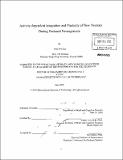Activity-dependent integration and plasticity of new neurons during postnatal neurogenesis
Author(s)
Lin, Chia-Wei
DownloadFull printable version (17.33Mb)
Other Contributors
Massachusetts Institute of Technology. Dept. of Brain and Cognitive Sciences.
Advisor
Carlos Lois.
Terms of use
Metadata
Show full item recordAbstract
Most neurons are born during the embryonic period to become the building blocks for a variety of brain circuits. However, two brain regions only start to assemble during the postnatal period. Both brain areas, olfactory bulb and dentate gyrus, mainly accommodate the integration of new neurons during the postnatal period, and continuously receive new neurons throughout animals' life. In this thesis, I used the rat olfactory bulb (OB) as a model system to address two important issues regarding the integration and plasticity of new neurons generated during the postnatal period. The first feature of postnatal neurogenesis is that when new neurons arrive and integrate into an adult OB, only half of neurons can ultimately survive. However, what form of activity pattern determines the survival of new neurons remains unclear. Using NaChBac sodium channels to selectively alter the intrinsic excitability of new neurons in vivo, this manipulation reveals that neuronal survival critically depends on the level of membrane depolarization. Once neurons integrate and survive in the brain circuits, neurons have the capability of monitoring their activity level and adaptively maintain their membrane excitability within the operational range. How they achieve the long-term stability of membrane excitability remains unclear. By altering the resting membrane potential of individual neurons in vivo, OB granule neurons are found to use a subthreshold parameter, resting membrane potential, to guide the compensatory changes of intrinsic ion channels and synaptic receptors. In summary, studies from this thesis have revealed the cellular mechanisms underlying neuronal survival in an in vivo brain circuit. I also uncover a novel form of homeostatic computation by which granule neurons preferentially use the subthreshold membrane potential response rather than spiking rates as a set point.
Description
Thesis (Ph. D.)--Massachusetts Institute of Technology, Dept. of Brain and Cognitive Sciences, 2010. Cataloged from PDF version of thesis. Includes bibliographical references.
Date issued
2010Department
Massachusetts Institute of Technology. Department of Brain and Cognitive SciencesPublisher
Massachusetts Institute of Technology
Keywords
Brain and Cognitive Sciences.